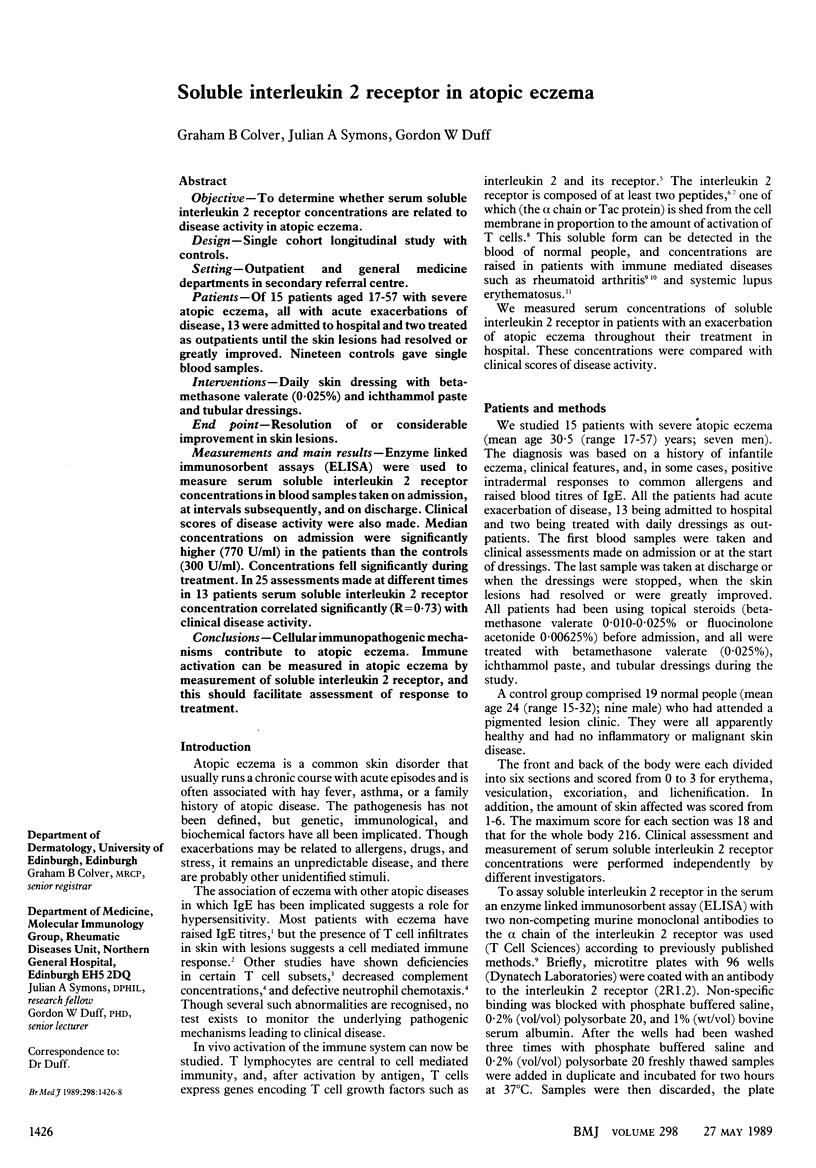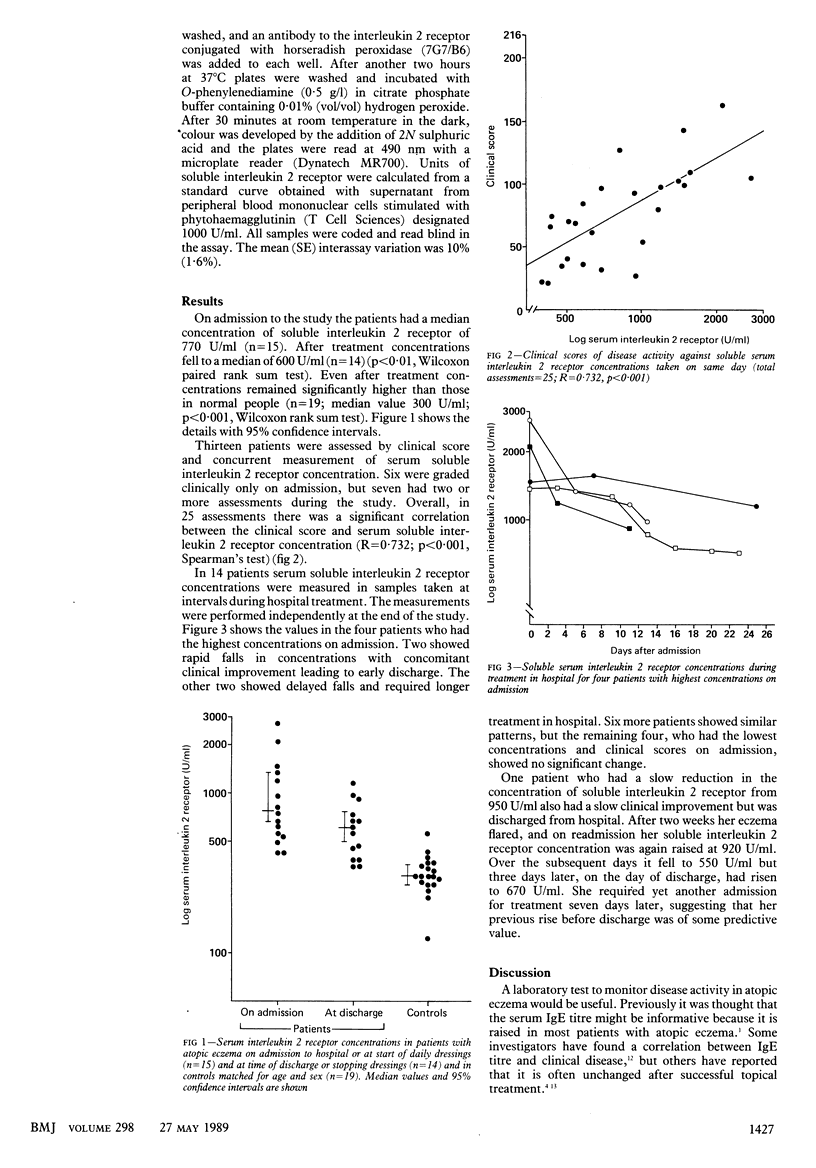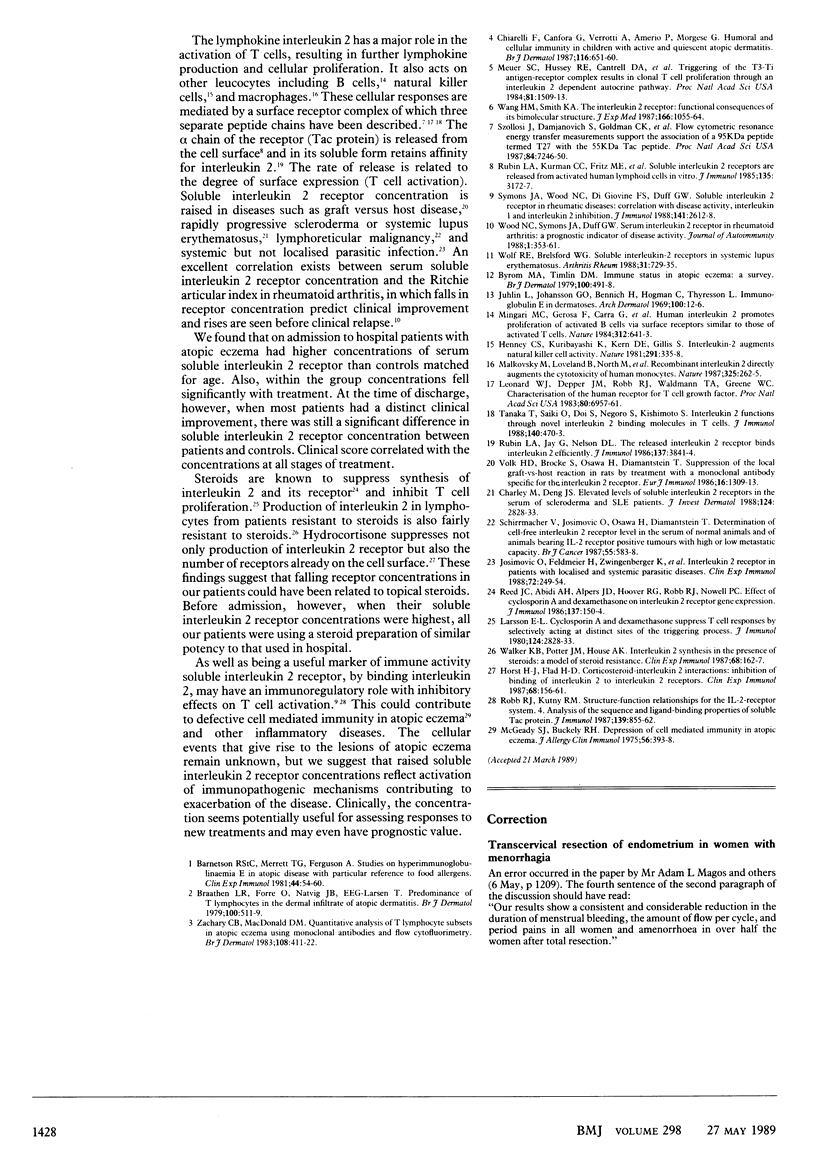Abstract
OBJECTIVE--To determine whether serum soluble interleukin 2 receptor concentrations are related to disease activity in atopic eczema. DESIGN--Single cohort longitudinal study with controls. SETTING--Outpatient and general medicine departments in secondary referral centre. PATIENTS--Of 15 patients aged 17-57 with severe atopic eczema, all with acute exacerbations of disease, 13 were admitted to hospital and two treated as outpatients until the skin lesions had resolved or greatly improved. Nineteen controls gave single blood samples. INTERVENTIONS--Daily skin dressing with betamethasone valerate (0.025%) and ichthammol paste and tubular dressings. END POINT--Resolution of or considerable improvement in skin lesions. MEASUREMENTS AND MAIN RESULTS--Enzyme linked immunosorbent assays (ELISA) were used to measure serum soluble interleukin 2 receptor concentrations in blood samples taken on admission, at intervals subsequently, and on discharge. Clinical scores of disease activity were also made. Median concentrations on admission were significantly higher (770 U/ml) in the patients than the controls (300 U/ml). Concentrations fell significantly during treatment. In 25 assessments made at different times in 13 patients serum soluble interleukin 2 receptor concentration correlated significantly (R = 0.73) with clinical disease activity. CONCLUSIONS--Cellular immunopathogenic mechanisms contribute to atopic eczema. Immune activation can be measured in atopic eczema by measurements of soluble interleukin 2 receptor, and this should facilitate assessment of response to treatment.
Full text
PDF


Selected References
These references are in PubMed. This may not be the complete list of references from this article.
- Barnetson R. S., Merrett T. G., Ferguson A. Studies on hyperimmunoglobulinaemia E in atopic diseases with particular reference to food allergens. Clin Exp Immunol. 1981 Oct;46(1):54–60. [PMC free article] [PubMed] [Google Scholar]
- Byrom N. A., Timlin D. M. Immune status in atopic eczema: a survey. Br J Dermatol. 1979 May;100(5):491–498. doi: 10.1111/j.1365-2133.1979.tb05574.x. [DOI] [PubMed] [Google Scholar]
- Chiarelli F., Canfora G., Verrotti A., Amerio P., Morgese G. Humoral and cellular immunity in children with active and quiescent atopic dermatitis. Br J Dermatol. 1987 May;116(5):651–660. doi: 10.1111/j.1365-2133.1987.tb05898.x. [DOI] [PubMed] [Google Scholar]
- Henney C. S., Kuribayashi K., Kern D. E., Gillis S. Interleukin-2 augments natural killer cell activity. Nature. 1981 May 28;291(5813):335–338. doi: 10.1038/291335a0. [DOI] [PubMed] [Google Scholar]
- Horst H. J., Flad H. D. Corticosteroid-interleukin 2 interactions: inhibition of binding of interleukin 2 to interleukin 2 receptors. Clin Exp Immunol. 1987 Apr;68(1):156–161. [PMC free article] [PubMed] [Google Scholar]
- Josimovic-Alasevic O., Feldmeier H., Zwingenberger K., Harms G., Hahn H., Shrisuphanunt M., Diamantstein T. Interleukin 2 receptor in patients with localized and systemic parasitic diseases. Clin Exp Immunol. 1988 May;72(2):249–254. [PMC free article] [PubMed] [Google Scholar]
- Juhlin L., Johansson G. O., Bennich H., Högman C., Thyresson N. Immunoglobulin E in dermatoses. Levels in atopic dermatitis and urticaria. Arch Dermatol. 1969 Jul;100(1):12–16. doi: 10.1001/archderm.100.1.12. [DOI] [PubMed] [Google Scholar]
- Larsson E. L. Cyclosporin A and dexamethasone suppress T cell responses by selectively acting at distinct sites of the triggering process. J Immunol. 1980 Jun;124(6):2828–2833. [PubMed] [Google Scholar]
- Leonard W. J., Depper J. M., Robb R. J., Waldmann T. A., Greene W. C. Characterization of the human receptor for T-cell growth factor. Proc Natl Acad Sci U S A. 1983 Nov;80(22):6957–6961. doi: 10.1073/pnas.80.22.6957. [DOI] [PMC free article] [PubMed] [Google Scholar]
- Malkovský M., Loveland B., North M., Asherson G. L., Gao L., Ward P., Fiers W. Recombinant interleukin-2 directly augments the cytotoxicity of human monocytes. Nature. 1987 Jan 15;325(6101):262–265. doi: 10.1038/325262a0. [DOI] [PubMed] [Google Scholar]
- McGeady S. J., Buckley R. H. Depression of cell-mediated immunity in atopic eczema. J Allergy Clin Immunol. 1975 Nov;56(5):393–406. doi: 10.1016/0091-6749(75)90133-5. [DOI] [PubMed] [Google Scholar]
- Meuer S. C., Hussey R. E., Cantrell D. A., Hodgdon J. C., Schlossman S. F., Smith K. A., Reinherz E. L. Triggering of the T3-Ti antigen-receptor complex results in clonal T-cell proliferation through an interleukin 2-dependent autocrine pathway. Proc Natl Acad Sci U S A. 1984 Mar;81(5):1509–1513. doi: 10.1073/pnas.81.5.1509. [DOI] [PMC free article] [PubMed] [Google Scholar]
- Mingari M. C., Gerosa F., Carra G., Accolla R. S., Moretta A., Zubler R. H., Waldmann T. A., Moretta L. Human interleukin-2 promotes proliferation of activated B cells via surface receptors similar to those of activated T cells. Nature. 1984 Dec 13;312(5995):641–643. doi: 10.1038/312641a0. [DOI] [PubMed] [Google Scholar]
- Reed J. C., Abidi A. H., Alpers J. D., Hoover R. G., Robb R. J., Nowell P. C. Effect of cyclosporin A and dexamethasone on interleukin 2 receptor gene expression. J Immunol. 1986 Jul 1;137(1):150–154. [PubMed] [Google Scholar]
- Robb R. J., Kutny R. M. Structure-function relationships for the IL 2-receptor system. IV. Analysis of the sequence and ligand-binding properties of soluble Tac protein. J Immunol. 1987 Aug 1;139(3):855–862. [PubMed] [Google Scholar]
- Rubin L. A., Jay G., Nelson D. L. The released interleukin 2 receptor binds interleukin 2 efficiently. J Immunol. 1986 Dec 15;137(12):3841–3844. [PubMed] [Google Scholar]
- Rubin L. A., Kurman C. C., Fritz M. E., Biddison W. E., Boutin B., Yarchoan R., Nelson D. L. Soluble interleukin 2 receptors are released from activated human lymphoid cells in vitro. J Immunol. 1985 Nov;135(5):3172–3177. [PubMed] [Google Scholar]
- Schirrmacher V., Josimovic-Alasevic O., Osawa H., Diamantstein T. Determination of cell-free interleukin 2 receptor level in the serum of normal animals and of animals bearing IL-2 receptor positive tumours with high or low metastatic capacity. Br J Cancer. 1987 Jun;55(6):583–587. doi: 10.1038/bjc.1987.119. [DOI] [PMC free article] [PubMed] [Google Scholar]
- Symons J. A., Wood N. C., Di Giovine F. S., Duff G. W. Soluble IL-2 receptor in rheumatoid arthritis. Correlation with disease activity, IL-1 and IL-2 inhibition. J Immunol. 1988 Oct 15;141(8):2612–2618. [PubMed] [Google Scholar]
- Szöllösi J., Damjanovich S., Goldman C. K., Fulwyler M. J., Aszalos A. A., Goldstein G., Rao P., Talle M. A., Waldmann T. A. Flow cytometric resonance energy transfer measurements support the association of a 95-kDa peptide termed T27 with the 55-kDa Tac peptide. Proc Natl Acad Sci U S A. 1987 Oct;84(20):7246–7250. doi: 10.1073/pnas.84.20.7246. [DOI] [PMC free article] [PubMed] [Google Scholar]
- Tanaka T., Saiki O., Doi S., Negoro S., Kishimoto S. Interleukin 2 functions through novel interleukin 2 binding molecules in T cells. J Immunol. 1988 Jan 15;140(2):470–473. [PubMed] [Google Scholar]
- Volk H. D., Brocke S., Osawa H., Diamantstein T. Suppression of the local graft-vs.-host reaction in rats by treatment with a monoclonal antibody specific for the interleukin 2 receptor. Eur J Immunol. 1986 Oct;16(10):1309–1312. doi: 10.1002/eji.1830161020. [DOI] [PubMed] [Google Scholar]
- Walker K. B., Potter J. M., House A. K. Interleukin 2 synthesis in the presence of steroids: a model of steroid resistance. Clin Exp Immunol. 1987 Apr;68(1):162–167. [PMC free article] [PubMed] [Google Scholar]
- Wang H. M., Smith K. A. The interleukin 2 receptor. Functional consequences of its bimolecular structure. J Exp Med. 1987 Oct 1;166(4):1055–1069. doi: 10.1084/jem.166.4.1055. [DOI] [PMC free article] [PubMed] [Google Scholar]
- Wolf R. E., Brelsford W. G. Soluble interleukin-2 receptors in systemic lupus erythematosus. Arthritis Rheum. 1988 Jun;31(6):729–735. doi: 10.1002/art.1780310605. [DOI] [PubMed] [Google Scholar]
- Wood N. C., Symons J. A., Duff G. W. Serum interleukin-2-receptor in rheumatoid arthritis: a prognostic indicator of disease activity? J Autoimmun. 1988 Aug;1(4):353–361. doi: 10.1016/0896-8411(88)90005-4. [DOI] [PubMed] [Google Scholar]
- Zachary C. B., MacDonald D. M. Quantitative analysis of T-lymphocyte subsets in atopic eczema, using monoclonal antibodies and flow cytofluorimetry. Br J Dermatol. 1983 Apr;108(4):411–422. doi: 10.1111/j.1365-2133.1983.tb04593.x. [DOI] [PubMed] [Google Scholar]


